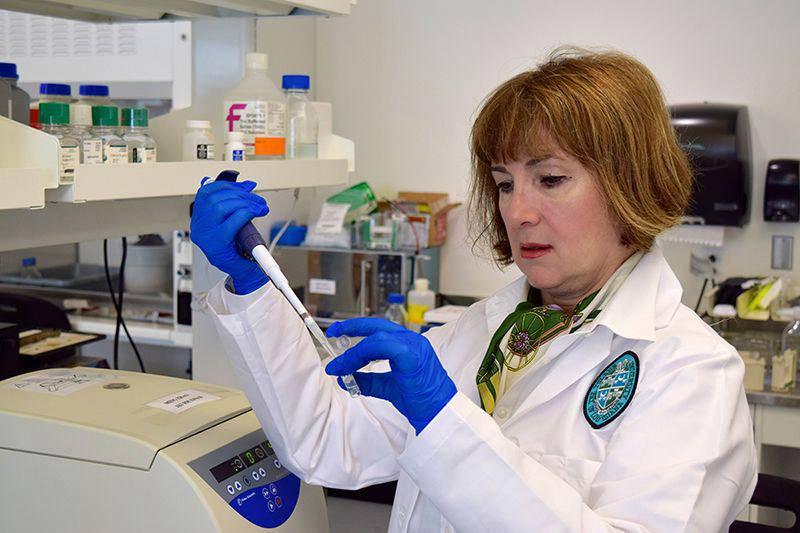Researcher investigates possible link between obesity and colon cancer
Obesity is associated with an increased risk for a broad spectrum of tumors, including colon cancer. And once cancer develops, statistics show that overweight or obese individuals are at higher risk of cancer recurrence and have a decreased chance of survival. The underlying mechanisms for this are unclear.
One of the emerging possibilities with regard to colon cancer is that excess lipids — a class of organic compounds, including fats, that are insoluble in water — accumulate in both the fat-storing and non-fat-storing tissues of obese individuals. These intracellular lipids are stored in droplets (LDs) and are seen at higher volumes in colonic tumors relative to normal tissues. It is theorized that these droplets not only drive inflammation in the colonic epithelium, but they could also be the energy source that drives colon tumor formation and growth.
“In order for cancer cells to grow and persist, they need fuel,” said Suzana Savkovic, PhD, associate professor of pathology and laboratory medicine. “Overweight or obese individuals store excess energy in the form of fat, and cancer cells derive their energy from muscles and fat. So, we know obesity and cancer progression are connected, but we don't yet fully understand how.” Savkovic and her team were recently awarded a five-year, $1.6 million National Cancer Institute grant to investigate the connection.
But lipid accumulation is not the only culprit, according to Savkovic. LD accumulation plus the suppression of a gene involved in halting tumor growth — the FOXO3 tumor suppressor gene — seem to represent a co-dependent signaling network that drives colon cancer progression.
“We discovered that when FOXO3 loses function, there is an increase in LD accumulation. The cells actually start to accumulate more food,” said Savkovic. Why is this important? Because LDs are actually changing these cells. Even if they were normal before, now they can become cancerous cells because they are storing LDs. And LDs provide the physical building blocks that cancer cells need to create new cells as they rapidly divide, as well as the fuel to support tumor growth.
There is also a third player in this process, according to Savkovic: enzymatic molecules called DGATs. Savkovic's preliminary data show that DGATs levels are elevated in human and mouse colonic tumors relative to normal tissues, with even higher levels in obese individuals and mice. Elevated DGATs are linked to poor patient survival.
“In the laboratory, inhibition of DGATs in human colonic-transformed cells blocked the pathway responsible for the loss of FOXO3, lowered LDs and prevented tumor cell growth,” said Savkovic. “The whole process is a big loop. We hypothesize that elevated levels of DGATs help to drive the LD/FOXO3 signaling network, and if we block DGATs, we can not only preserve FOXO3 tumor suppressor function, but also lower LD accumulation and in turn suppress tumor formation and growth. If we target DGATs, the rest of the loop falls apart.” This knowledge could provide opportunities to establish new therapeutic approaches for colon cancer.
Savkovic is especially excited that she and her team used the tissues of local colon cancer patients in generating the preliminary data that led to this grant. The tissues were acquired by and stored in the Louisiana Cancer Research Center’s (LCRC) Biospecimen Laboratory.
“These patients are from across the Greater New Orleans area, not just Tulane,” said Savkovic. “I feel so privileged that people from this community are contributing to this important research. We don't have to rely on others; we have a presence on the national scene.”
The LCRC — a cancer research partnership between Tulane, LSUHSC, Xavier and Ochsner — was created and funded by the State of Louisiana to help foster collaborative cancer research. Savkovic feels the resources it provides help to “drive her work.” In addition to utilizing the Biospecimen Core Laboratory, she has used the services of the Cancer Crusader’s Next Generation Sequence Analysis Core to help analyze her data, and her recent lecture to all LCRC faculty helped to kick start potential research collaborations with colleagues at LSUHSC and Ochsner.
“I’m so grateful to have an opportunity to give back to the community here based on what I do and what I know,” said Savkovic.

